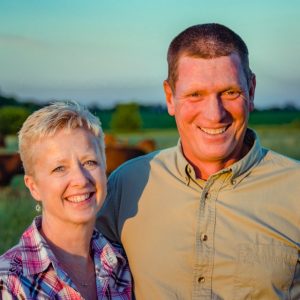
Grant and Dawn Breitkreutz of Stoney Creek Farm converted from “conventional” agriculture to a regenerative system involving holistic management of livestock, cover cropping, and soil-health techniques. Over the last fifteen years they have seen their farm thrive, their own health improve, and their land become more lush, resilient, and hospitable to wildlife. They tell their story, with its challenges and learning experiences.
1’05 what their lives were like in conventional agriculture
2’08 what it was like to be the wife of a farmer working very long hours
3’06 adding cattle when they bought out parents’ farm
4’24 when the went into holistic management they weren’t aware of soil health–at first
6’16 having aha moments about soil health
8’01 the learning process–and resistance
9’43 the psychology of making change
11’24 using the neighbors’ field that had lousy soil health–many learning curves
13’59 ongoing dialogue with Gabe Brown — changing perspective from yield per acre to profit per acre
15’04 cover crops, no-till, and other factors that drive down the price of production
15’44 big reduction in the cost of inputs
16’36 getting rid of corn with seed treatments e.g. neonicotinoids
17’50 goal is 100% no-till and certified organics
18’03 addressing “addictions”
19’45 putting cattle on crop land it that improves soil biology
20’31 shut down the feedlot
20’40 selling manure. stopped using so much manure because soil health had improved so much
21’58 eliminating toxicity
24’31 change in work life
25’18 restructuring the farm to make it sustainable for the family
25’37 direct marketing their meat
26’06 relationship to neighbors, how they’re reacting to the changes–or not reacting
27’03 they’ve been dealing well with a very heavy rainfall because of soil infiltration
28’39 lenders telling farmers how to manage their land
29’39 lenders don’t understand farm diversity even when it’s more profitable
30’21 seeing wildlife returning to the farm
31’14 providing habitat, and that’s OK
31’44 wildlife is thriving–white-tail deer having triplets
32’20 how to deal with deer eating the crops
32’56 charging for hunting because there are so many deer
33’18 vet bills way down
33’32 use virtually no antibiotics
33’56 the meat is healthier, and more marketable
34’44 story of people who’d given up meat who could start eating it again because it was healthy
37’00 Marker 35
37’00 the chronology of transformations
37’56 plans for the future
39’34 neighbors asking them to transition their farm
40’35 greatest rewards of regenerative agriculture
41’06 the land is so much more beautiful
42’11 looking at the life on the farm instead of what they’re going to kill
43’17 they haven’t had to spray for aphids because the predatory insects are eating them, and not hurting the crops
44’40 relationship with their farming and their religious spirituality
46’11 better to work with nature instead of fighting against it
47’30 nurturing community
47’45 sharing rather than being competitive
49’02 measuring soil organic matter
49’43 improving soils more quickly than they thought possible
50’53 how it’s catching on, General Mills
51’31 teaching legislators about soil health



Subscribe:
Apple Podcasts
Spotify